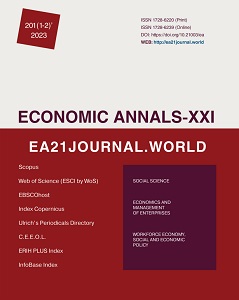System characteristics and matrix tools for evaluating innovative business models of youth tourism
System characteristics and matrix tools for evaluating innovative business models of youth tourism
Author(s): Dinara Mamrayeva, Larissa Tashenova, Meiramgul AyaganovaSubject(s): Social Sciences, Economy, Economic policy, Tourism
Published by: Institute of Society Transformation
Keywords: Innovative Business Model; Youth Tourism; Functional and Innovative Approach; Holistic Approach; Business Models in Tourism; Matrix Diagrams; Scientometric Analysis;
Summary/Abstract: This scientific article is devoted to the issues of identifying innovative business models of youth tourism based on two scientific approaches: functional-innovative (customized business model, virtual tourism platform, franchising business model) and holistic (shared tourism platforms, outdoor co-working tourism, organization of youth hostels, mobile karaoke bars and pub for youth, developing tourism programs (including package tours) for social networks, couchsurfing tours for youth, personalized tourism offers for young people, the organization of «combo tours» (combination of several types of tourism), crowdsourcing tourism, organization of tours in the format of «digital nomads», organization of tree tours, transformational tourism, digital tourism, organization of tours with ATVs, mopeds and bicycles). Furthermore, the study was able to identify conceptual business models that describe the specific characteristics and components of the different types of youth tourism: close interaction between tour operator, travel agency and end consumer based on the use of digital solutions; partial involvement of tour operators and travel agencies in the design of the tourist offer or without; involvement of third parties not directly connected with the tourism market; the presence of a large number of intermediaries; pronounced customization of services; participation of the main players in the tourist market of service organizations through intermediaries; organization of trips without physical departure using digital tools; close interaction of individuals in the process of organizing trips based on digital platforms. In the work, a scientometric and content analysis of search queries was conducted to identify important research areas within the framework of the scientific problems considered by the authors (the total amount of information used for the study was 4309 scientific documents; at the same time, the number of search queries processed in Google Trends was 4 units with an average observation period of 5 years); in addition, the distinguishing features of classic and innovative business models, including those related to the tourism business, were identified, a matrix for the correspondence of conceptual and specific business models of youth tourism was created, as well as their distribution according to three selected criteria: the level of formation of tourist interest and personalization, the degree of involvement of the tourist in the process of providing tourist services. It is also important to note that based on the results of the study, a conceptual scheme for the correlation of organizational functions and the formation of structural units and organizational links within a tourism company in the selection of the optimal innovative business model for youth tourism was developed.
Journal: Економічний часопис - ХХІ
- Issue Year: 201/2023
- Issue No: 01+02
- Page Range: 56-72
- Page Count: 17
- Language: English

